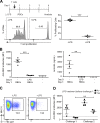Bridging channel dendritic cells induce immunity to transfused red blood cells
- PMID: 27185856
- PMCID: PMC4886363
- DOI: 10.1084/jem.20151720
Bridging channel dendritic cells induce immunity to transfused red blood cells
Abstract
Red blood cell (RBC) transfusion is a life-saving therapeutic tool. However, a major complication in transfusion recipients is the generation of antibodies against non-ABO alloantigens on donor RBCs, potentially resulting in hemolysis and renal failure. Long-lived antibody responses typically require CD4(+) T cell help and, in murine transfusion models, alloimmunization requires a spleen. Yet, it is not known how RBC-derived antigens are presented to naive T cells in the spleen. We sought to answer whether splenic dendritic cells (DCs) were essential for T cell priming to RBC alloantigens. Transient deletion of conventional DCs at the time of transfusion or splenic DC preactivation before RBC transfusion abrogated T and B cell responses to allogeneic RBCs, even though transfused RBCs persisted in the circulation for weeks. Although all splenic DCs phagocytosed RBCs and activated RBC-specific CD4(+) T cells in vitro, only bridging channel 33D1(+) DCs were required for alloimmunization in vivo. In contrast, deletion of XCR1(+)CD8(+) DCs did not alter the immune response to RBCs. Our work suggests that blocking the function of one DC subset during a narrow window of time during RBC transfusion could potentially prevent the detrimental immune response that occurs in patients who require lifelong RBC transfusion support.
© 2016 Calabro et al.
Figures




References
-
- Bachem A., Hartung E., Güttler S., Mora A., Zhou X., Hegemann A., Plantinga M., Mazzini E., Stoitzner P., Gurka S., et al. . 2012. Expression of XCR1 Characterizes the Batf3-dependent lineage of dendritic cells capable of antigen cross-presentation. Front. Immunol. 3:214 10.3389/fimmu.2012.00214 - DOI - PMC - PubMed
-
- Borges da Silva H., Fonseca R., Cassado A.A., Machado de Salles É., de Menezes M.N., Langhorne J., Perez K.R., Cuccovia I.M., Ryffel B., Barreto V.M., et al. . 2015. In vivo approaches reveal a key role for DCs in CD4+ T cell activation and parasite clearance during the acute phase of experimental blood-stage malaria. PLoS Pathog. 11:e1004598 10.1371/journal.ppat.1004598 - DOI - PMC - PubMed
Publication types
MeSH terms
Substances
LinkOut - more resources
Full Text Sources
Other Literature Sources
Molecular Biology Databases
Research Materials

